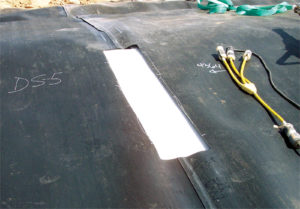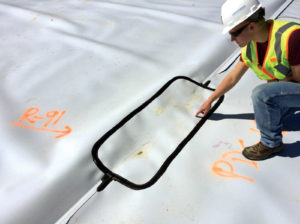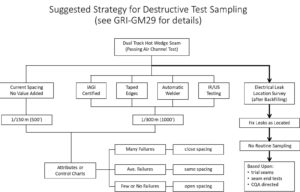
The late Henry Haxo Jr., Ph.D., former president of Matrecon Inc., deserves considerable credit for developing many of the concepts and practices involved in waste containment liner and cover systems. Beginning in the 1970s, various projects, many of them funded by the U.S. Environmental Protection Agency (EPA), were actively researched. His capstone document is the 1,069-page report in September 1988 designated as EPA/600/2-82/052. It references the minimum sampling of geomembrane field seams at the rate of one per 500 feet (152 m). Haxo states that Wright et al. (1987) originally made the recommendation. This amount of periodic destructive testing is embedded in regulations in many U.S. states (and in some countries worldwide) and has become entrenched in geomembrane installation practice as well as being evaluated by construction quality assurance (CQA) personnel. Figures 1 and 2 show a removed geomembrane field seam sample that was then sent to a geosynthetics laboratory for testing to see if the project specification values were met. Also shown is the patch made to repair such a sampling area.

While such sampling is certainly possible and is done on a regular basis, it is not without many disadvantages. Furthermore, the fundamental practice of making field seams has progressed meaningfully over the past 30 plus years. The following items come to mind:
- Geomembrane seaming devices have improved from extrusion flat, to extrusion fillet, to single hot wedge, to double hot wedge methods over the years.
- The double hot wedge seam allows for a nondestructive air channel testing method.
- Hot wedge seaming does not require surface grinding of the sheets.
- Off-site testing of destructive seams is both time-consuming and represents added expense.
- Statistical sampling methods are now available (for the methods of attributes and control charts, see GRI-GM14 and GRI-GM20, respectively), which provide spacing flexibility and rewards good installers (opens spacing) and penalizes poor installers (closes spacing).
- A geosynthetic installer’s certification program is now available for both installation companies and individual installers from the International Association of Geosynthetic Installers (IAGI). See www.iagi.org.
- Geomembrane sheet edges (tops and bottoms) can be manufactured with protective films, which are stripped off immediately before seaming, leaving the area to be bonded both clean and dry.
- Automatic hot wedge welders are available, which continuously track the surface temperature of the sheets and can digitally regulate the device’s seaming speed.
- Infrared and ultrasonic methods are available for nondestructive seam testing.
- The electrical leak location (ELL) survey method is now fully developed. Importantly, it evaluates the integrity of both the seams and the sheets themselves. There are five separate standards available for the variations of the method (ASTM D7002, D7003, D7007, D7240 and D7953).

Considering these ten items all developed since the one per 500 feet sampling interval was first advanced, a major shift in destructive seam testing seems warranted. The recommended process is embodied in Figure 3. See https://geo synthetic-institute.org/grispecs/gm29.pdf for additional details. The entire process begins with a seam of any length passing the air channel test of a dual-track hot wedge seam. Thereafter, three separate changes to the one in 500 feet (152 m) spacing strategy are suggested:
- Minor change: Begin seaming with the one in 500 feet (152 m) spacing, but then modify it according to statistical methods insofar as closing, maintaining or opening the spacing as seaming progresses.
- Intermediate change: If any of the four “value added” installers criteria are initiated, increase the spacing initially to one in 1,000 feet (305 m) but then modify it per one of the statistical methods.
- Major changes: Go directly to using the ELL survey method and repair holes or defects in both seams and sheet as indicated. This can be done before and/or after backfilling. The only destructive tests would be on trial seams, on seam ends and as the CQA personnel direct.
In summary, we feel that geomembrane installation practices have advanced significantly since the original “one in 500 feet” (152 m) paradigm was advanced. The key to changes in this regard is, of course, the regulatory community, since liner waste containment regulations are involved. These regulations must be changed or modified at least on a provisional basis. We are available to interact in this regard insofar as possible.
 TEXTILES.ORG
TEXTILES.ORG


